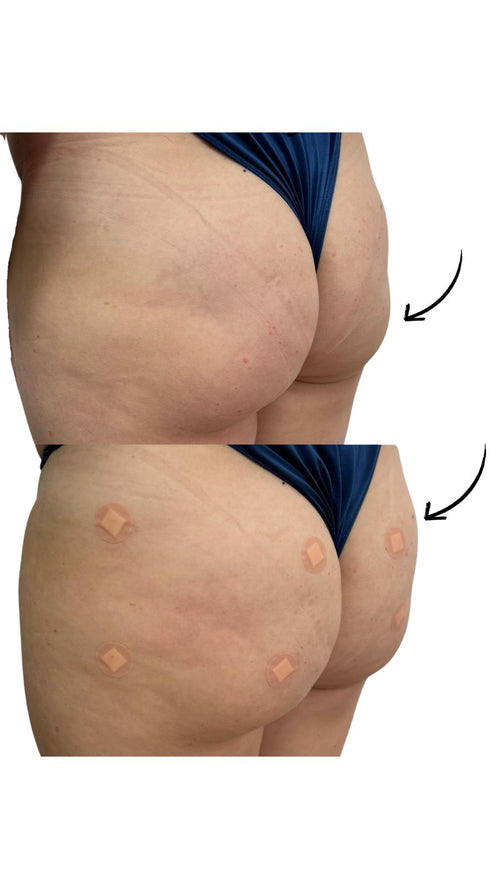Get a Brazilian Butt Lift (BBL) at It’s Me & You Clinic today!
Commonly Used Fillers
Fillers are substances injected into the buttocks to enhance their size, shape, and overall appearance.
Hyaluronic acid (HA) is one of the most commonly used fillers for this purpose.
Here’s a breakdown of how HA works as a bum filler ingredient:
-
Naturally occurring substance: Hyaluronic acid is a naturally occurring sugar molecule found in the body, especially in the skin. It acts like a sponge, attracting and holding water.
-
Plumping effect: When injected into the buttocks, HA attracts water molecules, increasing volume and creating a fuller, more sculpted look.
-
Temporary results: Unlike permanent fillers, HA-based injections are temporary. The effects typically last 6 to 18 months, after which the body naturally breaks down the HA.
-
Smooth application: HA fillers come in various viscosities (thicknesses) allowing for precise placement and customization of the desired shape.
Beyond hyaluronic acid, other common bum filler ingredients include:
-
Poly-L-lactic acid (PLLA): This biocompatible and biodegradable material stimulates collagen production, gradually increasing volume over time. Results are longer-lasting than HA.
-
Calcium hydroxylapatite: This synthetic material provides immediate volume enhancement and can also trigger collagen growth.
The choice of filler depends on individual needs, desired results, budget, and consultation with a qualified medical professional.
Calcium hydroxylapatite (CaHA) is a common filler used in cosmetic procedures, particularly for facial augmentation and wrinkle reduction.
Here’s why CaHA is a popular choice:
-
Natural Occurrence:
CaHA is naturally found in the body as a component of bones and teeth. This biocompatibility means it is generally well-tolerated by the body.
-
Volumizing Effect:
CaHA particles are relatively large, providing immediate volume to the treated area. It effectively plumps up areas that have lost volume due to aging or genetics.
-
Stimulation of Collagen Production:
CaHA acts as a scaffold for collagen growth, stimulating the skin’s natural collagen production over time. This helps to improve skin elasticity and firmness, resulting in long-lasting results.
-
Versatile Application:
CaHA can be used to treat various areas of the face, including the cheeks, temples, lips, jawline, and around the eyes. It’s also effective for addressing nasolabial folds (laugh lines) and marionette lines.
Important Note:
While CaHA is a generally safe filler, potential side effects can occur, such as bruising, swelling, redness, and pain. These are typically temporary and subside within a few days to weeks. It’s essential to consult with a qualified and experienced medical professional to discuss your individual needs and expectations before undergoing any cosmetic injections.
Poly-L-lactic acid (PLLA) is a commonly used filler in cosmetic procedures, including buttock augmentation.
PLLA is a synthetic, biocompatible, and biodegradable polymer. It’s known for its ability to stimulate collagen production within the body.

When injected, PLLA particles act as a scaffold, encouraging the growth of new collagen fibers over time. This gradual collagen synthesis results in a volumizing effect, increasing the size and definition of the buttocks.
One advantage of PLLA is its longevity. Unlike some other fillers that dissolve within months, PLLA’s effects can last for several years.
PLLA injections are typically performed using multiple sessions spaced several weeks apart. This allows for gradual volume buildup as collagen production continues.
The procedure is generally well-tolerated with minimal downtime. Most patients experience some mild swelling and bruising at the injection sites, which subsides within a few days.
PLLA is considered a safe and effective option for individuals seeking to enhance their buttock size and shape.
Variations in Ingredients
When it comes to bum filler injections, there are several key ingredients used, depending on the desired outcome and specific area being treated.
Book a Dermal Filler Consultation with Dr. Laura Geige at It’s Me and You Clinic
The most common ingredient is hyaluronic acid (HA), a naturally occurring substance in the body that provides volume and hydration.
Different types of HA fillers are available, each with varying viscosities and properties suited for different areas:
- For Gluteal Augmentation: Hyaluronic acid fillers with higher concentrations and densities are used to create significant volume and lift in the buttocks.
- For Contouring and Shaping: Less dense HA fillers can be used for refining curves, enhancing muscle definition, and smoothing out imperfections.
Other ingredients sometimes used in bum filler injections include:
- Calcium hydroxylapatite (CaHA): This biocompatible material provides a more structured support compared to HA fillers. It’s known for its long-lasting results and is often chosen for patients seeking a more permanent solution.
- Poly-L-lactic acid (PLLA): This synthetic material stimulates collagen production in the body, gradually increasing volume and firmness over time.
The specific choice of filler depends on several factors, including the patient’s desired outcome, skin thickness, existing fat distribution, and individual medical history.
Bum filler injections, also known as Brazilian butt lifts or BBLs, primarily utilize hyaluronic acid (HA) based gels as their core ingredient.
These HA gels are synthetic substances designed to mimic the body’s natural hyaluronic acid, which is a sugar molecule that plays a crucial role in skin hydration and elasticity. The variations in bum filler injections stem from the specific types of HA used, their concentration levels, and their viscosities.
HA gels come in various cross-linking densities, affecting their longevity and firmness. Cross-linking refers to the chemical bonds formed between HA molecules, influencing the gel’s structure. Highly cross-linked HA provides a firmer, longer-lasting result, while less cross-linked HA offers more flexibility and is typically used for subtle enhancements.
Concentration levels of HA also vary, directly impacting the volume added during the procedure. Higher concentrations deliver denser gels suitable for significant augmentation, whereas lower concentrations are preferred for contouring and subtle volumization.
Viscosity describes the thickness or flowability of the gel. A higher viscosity indicates a thicker gel, better suited for structural support and shaping larger areas. Lower viscosity gels are more fluid, allowing for precise placement and smoother blending with natural tissue.
The choice of HA filler, concentration level, and viscosity depends on individual patient needs, desired outcome, and anatomical considerations. A qualified injector will carefully assess these factors to determine the most appropriate product and technique for each case, ensuring a safe and aesthetically pleasing result.
Factors Influencing Ingredient Choice
When choosing ingredients for bum filler injections, several key factors come into play, all aimed at achieving desired results while ensuring longevity.
Ingredient Factors
- Type of Filler:
- Purity and Concentration: High-purity HA is crucial to minimize risks like inflammation or allergic reactions. The concentration of HA determines the volume and lift achieved.
- Cross-Linking Density:
The primary decision revolves around the type of filler used. Hyaluronic acid (HA) based fillers are most common, renowned for their ability to attract and hold water, effectively volumizing the buttocks.
Cross-linking refers to the degree of chemical bonds between HA molecules, influencing the filler’s firmness and longevity. A higher cross-linking density results in a longer-lasting effect.
Desired Results
- Volume Enhancement: The primary goal is often to increase the size and fullness of the buttocks, creating a more shapely and defined silhouette.
- Lift and Contouring: Fillers can strategically lift and sculpt the buttocks, addressing areas like a flat or saggy appearance.
- Symmetry and Balance: Injections aim to even out asymmetry between the buttocks, achieving a more balanced and harmonious look.
Longevity
The duration of results varies depending on several factors:
-
It’s Me & You Clinic: Transforming lives with Brazilian Bum Lift treatments.
- Type and concentration of filler used;
- Individual metabolism and skin elasticity;
- Lifestyle choices (sun exposure, smoking)
On average, HA-based fillers can last anywhere from 6 months to 2 years. Regular touch-up injections are typically required to maintain the desired results.
When selecting ingredients for dermal filler injections like “Bum Filler,” several factors come into play, all aimed at achieving safe and effective results tailored to individual patients.
A crucial factor is the patient’s skin type. Oily skin might benefit from hyaluronic acid fillers with a slightly denser consistency, as they can better withstand sebum production. Conversely, dry skin could be more compatible with hyaluronic acid fillers that are thinner and more hydrating.
Skin condition plays an equally important role. Active acne or inflammation generally requires careful ingredient selection to avoid irritation. In these cases, gentle, biocompatible fillers derived from naturally occurring substances like hyaluronic acid might be preferred. Patients with sensitive skin may also benefit from hypoallergenic formulas.
The desired outcome significantly influences ingredient choice. For volumizing the buttocks, a thicker, more cohesive filler might be necessary to provide structural support and lasting results. A thinner filler might be suitable for subtle contouring or smoothing lines and wrinkles.
Beyond hyaluronic acid, other ingredients like poly-L lactic acid (PLLA) are gaining popularity in dermal fillers. PLLA stimulates collagen production over time, offering long-lasting volumization and skin rejuvenation. However, it may not be suitable for all patients due to potential side effects like temporary redness or swelling.
It’s essential to remember that individual patient needs vary widely. A qualified medical professional should carefully assess the patient’s skin type, condition, desired outcome, and any potential allergies before selecting the most appropriate ingredients for dermal filler injections.
Ingredient selection for dermal fillers like bum fillers is a multifaceted process influenced by several key factors.
Firstly, safety and efficacy are paramount considerations. Fillers must be biocompatible, meaning they don’t trigger harmful immune reactions or rejection by the body.
This often involves using hyaluronic acid (HA), a naturally occurring substance in skin that attracts and retains moisture, providing volume and plumpness.
Different HA fillers vary in their molecular weight and cross-linking density, affecting their longevity and suitability for specific areas.
Other common filler ingredients include calcium hydroxylapatite, a mineral derivative, and poly-L-lactic acid, which stimulates collagen production.
The desired aesthetic outcome also plays a crucial role.
For bum augmentation, volumizing and lifting effects are sought after. Fillers with cohesive gel structures that can be sculpted precisely are preferred to achieve the desired shape and contours.
Additionally, individual patient characteristics influence ingredient choice. Skin type, existing filler history, and potential allergies or sensitivities must be carefully assessed.
For instance, patients with sensitive skin may benefit from fillers formulated with lower concentrations of cross-linking agents to minimize the risk of irritation.
Moreover, underlying medical conditions like bleeding disorders require specific considerations when selecting filler ingredients.
It’s important to note that potential allergies or sensitivities to certain fillers exist.
Reactions can range from mild redness and swelling to more serious complications like anaphylaxis in rare cases.
Thorough patient history taking, including allergy screening and patch testing when necessary, is crucial for minimizing risks.
Ultimately, the best filler ingredient choice is a personalized decision made in consultation with a qualified medical professional who can assess individual needs and ensure safe and effective treatment.
Azmia Magane Pinnacle Wellbeing Media Bye Bye Belly Blog Dejour Magazine My Better Love
- Upper Face Anti Wrinkle Treatment Near Weybridge, Surrey - December 29, 2024
- What Are The Key Ingredients In Bum Filler Injections? - December 16, 2024
- Downturned Smile Treatment Near Shackleford, Surrey - December 13, 2024
